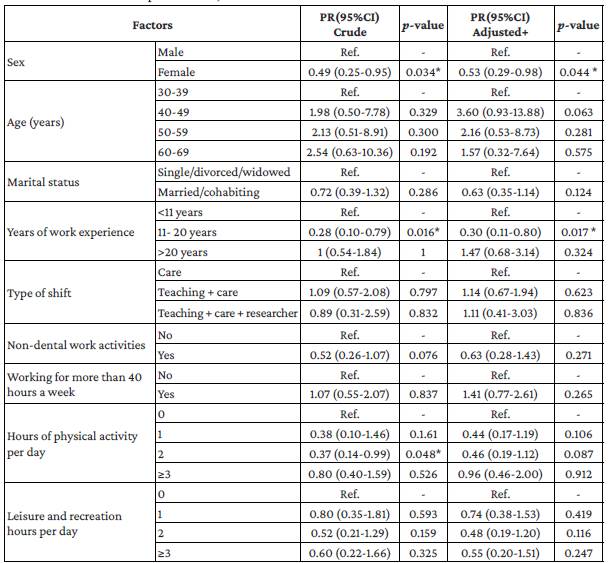Introduction
Burnout syndrome, or occupational burnout, is a condition that occurs as a response to chronic work stress. It causes various physical, somatic and psychological alterations and involves three specific dimensions: emotional exhaustion, depersonalization (relationships with people in the work environment), and personal accomplishment (perception of the professional role). In recent years, it has become increasingly common among health professionals,1,2 including dentists, therefore it is necessary to recognize its complexity and to work to promote preventive actions. 3
In 2016, Chambers et al.,4 in a study of 1 487 members of the Association of Salaried Medical Specialists working at one of New Zealand's 20 district health boards found an overall burnout prevalence of 50%, with the most frequently associated factors being female sex (OR: 2.14, 95%CI: 1.68-2.73) and working more than 14 consecutive hours (OR: 1.43, 95%CI: 1.12-1.82). That same year, Jugale et al.,5 in a study of 116 dentists practicing in eastern Bangalore, India, found that 5.15% of the participants who responded to the questionnaire (n=68) had burnout.
In Latin America, Bonafé et al.6 conducted a study in Brazil with 60 dentists from the public health service in Araraquara, in which they found that the prevalence of burnout was 16.7%, with professionals with less than 10 years of work experience being the most affected. In Paraguay, Odgón-Lebrón & Diaz-Reissner7 reported that the prevalence of this syndrome was low (1.2%) in a sample of 83 dentists working in the 18th Health Region (Asunción), which was attributed to the fact that participants, in general, had favorable economic conditions and a stable romantic relationship. Finally, and contrary to the previous finding, in Peru, Robles-Velásquez & Cáceres-Gutiérrez, 8 in a study carried out in 117 dentists working in hospitals in Lima and Callao belonging to the Armed and Police Forces, the Social Security and the Ministry of Health (MINSA), identified a prevalence of severe burnout of 44.6%, with the female sex being the most affected with 65.6%.
The literature shows that the burnout syndrome is becoming increasingly common among dentists and that this increase is influenced by several risk factors such as age, sex, marital status, number of working and rest hours, years of professional practice, among others. 1-8 The professional practice of dentists and their working conditions vary depending on their social context, so burnout syndrome can occur differently in dentists from different regions, and even within the same region. 5-9
Peruvian dentists working in the public sector are subject to working conditions that depend on institutional regulations in force. 10,11 If these conditions, which involve aspects of both remuneration and care (working hours, number of patients scheduled, infrastructure, equipment, availability of materials, among others), are not the most appropriate, they can cause feelings of frustration, fatigue, irritability and discouragement, which in turn could trigger burnout4,7 and, consequently, affect the quality of care and productivity of the dentist. This latter aspect would also have an impact on the health system, hence the importance of identifying this syndrome and recognizing the factors associated with its development in order to establish an early and appropriate intervention.
At present, there are few studies on burnout syndrome in Peruvian dentists, so the objective of this study is to describe its prevalence and the factors associated with its development in dentists working in MINSA hospitals in the Lima Metropolitan Area, Peru.
Materials and methods
Analytical cross-sectional study. The study universe comprised 144 dentists working in the 11 MINSA hospitals the in the Lima Metropolitan Area. The sample size was determined using the ratio estimator formula, with a confidence level of 95%, accuracy of 5%, and prevalence of the syndrome of 55% (pilot study). Thus, the final sample was 105 dentists distributed through stratified sampling proportional to the size of each hospital. Random selection was carried out using the Epidat 4.2 software and each dentist was coded according to the institution to which they belonged.
The study included dentists who were working in these hospitals between December 2019 and January 2020 on a remunerated basis and who agreed to participate in the research by signing an informed consent. Participants who reported being medicated with anxiolytics and/or antidepressants, who were conducting postgraduate studies in these hospitals, and dental residents who worked under the modality established by the Board of Directors of the Dental Residency were excluded.
Burnout was measured using the Maslach Burnout Inventory (MBI) survey version translated into Spanish by Olivares-Faundez et al. 12 and validated in a sample of 957 Chilean professionals from different work units in 2012. It should be noted that although no cross-cultural adaptation of this instrument has been developed in Peru, it has already been used with satisfactory results in studies carried out in health professionals, 8,13,14 so it was decided to use it in the present study. Furthermore, the reliability of this survey, established by means of Cronbach's alpha, was good since it obtained a coefficient of 0.74.
The MBI instrument consists of 22 items distributed in the 3 dimensions that affect burnout, namely, emotional exhaustion (9 items), depersonalization (5 items), and personal accomplishment (8 items). Response options are expressed in 6 categories ranging from "never" to "every day".15 In the first dimension, scores >26 are defined as a high burnout level; 19-26, as an intermediate level; and <19, as a low level. For the second dimension, scores >9 correspond to a high burnout level; 6-9, to an intermediate level; and <6, to a low level. Finally, in the third dimension, scores >39 indicate a high burnout level; 34-39, an intermediate level; and <34, a low level. 2,13,16,17
Based on previous studies, 2,9,12,13,16,17 participants were considered to have burnout syndrome if they scored high on the emotional exhaustion and depersonalization dimensions but low on the personal accomplishment dimension because the latter is inversely proportional: higher scores mean that the person is far from suffering from burnout.
The factors evaluated were: sex, age, marital status, years of work experience (<11 years, 11-20 years, >20 years), type of work shift at the hospital (care, care + teaching, care + teaching + research), working more than 40 hours per week (yes/no), number of daily hours of physical activity and leisure and recreation (0, 1, 2, ≥3), and other working activities (yes/no), with any activity other than clinical-care, teaching and research in the dental area being considered as non-dental.
To ensure the confidentiality of the information, the questionnaires were delivered in a sealed envelope to each participant, who were requested to return them in the same manner. The survey lasted approximately 20 minutes and was administered by a single interviewer outside of the work setting and working hours, after coordination with each dentist.
The statistical analysis and management of the data was carried out using the SPSS version 25.00 and STATA version 15. Each dimension of the syndrome was analyzed, according to the MBI, based on the factors studied by means of bivariate Student's t-tests and analysis of variance (ANOVA), except when relating the emotional exhaustion dimension to age, type of shift and hours of leisure, for which the Kruskall-Wallis test was chosen due to the lack of normal distribution (according to the Shapiro-Willk test) and homoscedasticity of variances. The association between the presence of burnout syndrome and the factors studied was determined using the chi-square test. Crude and adjusted prevalence ratios (PR) were also obtained for the analysis of the association between the presence of the syndrome and the factors evaluated. A significance level of p<0.05 was considered for all statistical analyzes.
The present study took into account the ethical principles for medical research on human subjects established in the Declaration of Helsinki18 and was approved by the Ethics Committee of the Universidad Científica del Sur as stated in Minutes No. 384-2019-POS8 of December 4, 2019. Informed consent was obtained from all participants.
Results
With regard to sociodemographic and occupational characteristics, it was found that 50.47% (n=53) of the participants were women, 43.80% (n=46) were between 40 and 49 years, 67.61% (n=71) were married/cohabiting, 35.23% (n=37) had 11 to 20 years of work experience, 54.28% (n=57) worked only one shift, 59.04%% (n=62) performed only dental work activities, 71.42% (n=75) worked less than 40 hours per week, 38.09% (n=40) did not perform daily physical activity, and 35.23% (n=37) spent 2 hours per day on leisure and recreation activities Table 1.
Table 1 Characteristics of the dentists working in hospitals of the Ministry of Health in the Lima Metropolitan Area, Peru.
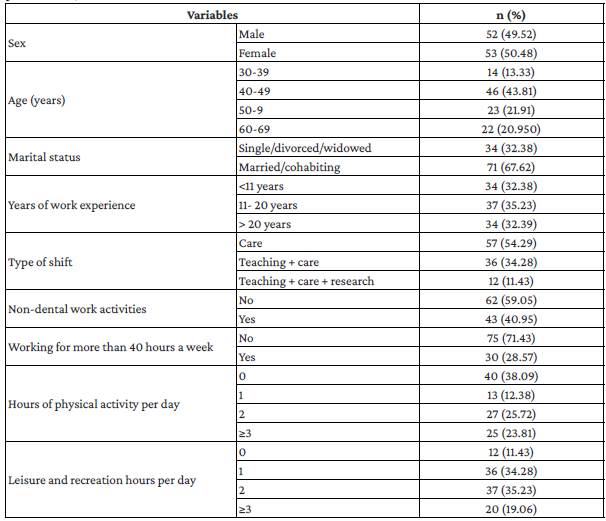
Source: Own elaboration.
The emotional exhaustion dimension was only significantly associated with the sex factor: levels in women were higher (40.38±5.21) than in men (36.50±8.46) (p=0.006) Table 2. When categorized by level, in this dimension, 10 participants (9.53%) were classified at the intermediate level and 95 (90.47%) at the high level; there were no cases at the low level.
Table 2 Emotional exhaustion dimension and associated factors in dentists working in hospitals of the Ministry of Health in the Lima Metropolitan Area, Peru.
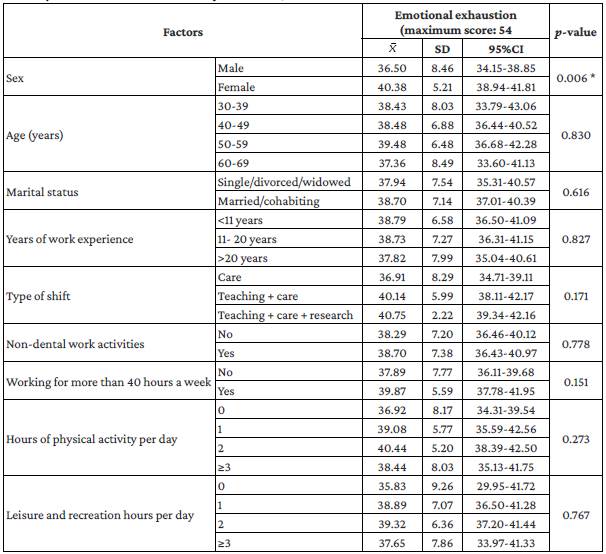
x̅: mean; SD: standard deviation; 95%CI: confidence interval.
* Statistically significant; Student's t test.
Source: Own elaboration.
As in the emotional exhaustion dimension, sex was the only factor with which a statistically signiicant association was established in the depersonalization dimension: levels in women (20.15±3.33) were higher than in men (18.17±3.73) (p=0.005) Table 3. When categorized by level, only 2 (1.91%) participants were classified in this dimension at the intermediate level and 103 (98.09%) at the high level; there were no cases at the low level.
Table 3 Depersonalization dimension and associated factors in dentists working in hospitals of the Ministry of Health in the Lima Metropolitan Area, Peru.
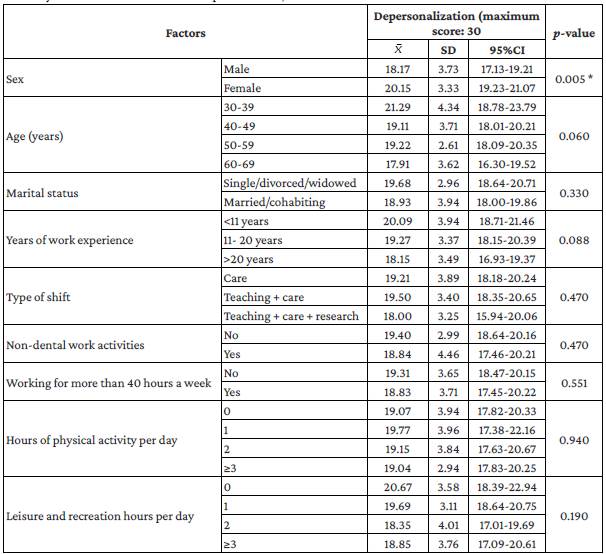
x̅: mean; SD: standard deviation; 95%CI: confidence interval.
* Statistically significant; Student's t test.
Source: Own elaboration.
The personal accomplishment dimension was significantly associated with two factors: levels were higher in the group of professionals with 11-20 years of practice (38.46±6.47) compared to those with less than 11 and more than 20 years (35.50±4.85 and 35.24±4.81, respectively) (p=0.024), and in those who perform some type of non-dental work activity (38.05±6.05) compared with those who did not (35.35±5.05) (p=0.015) Table 4. When categorized by level, 34 participants (32.38%) were classified in this dimension at the low level, 34 (32.38%) at the intermediate level, and 37 (35.24%) at the high level.
Table 4 Personal accomplishment dimension and associated factors in dentists working in hospitals of the Ministry of Health in the Lima Metropolitan Area, Peru.
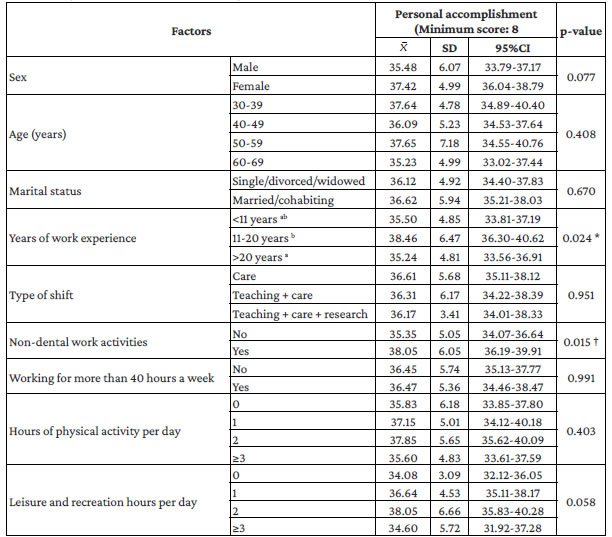
x̅: mean; SD: standard deviation; 95%CI: confidence interval.
* Statistically significant; ANOVA: a,b indicate differences between groups.
† Statistically significant; Student's t test.
Source: Own elaboration.
The prevalence of burnout syndrome was 28.57% (n=30), being less frequent in women than in men (18.87% vs. 38.46; p=0.026) and in those who had been practicing between 11 and 20 years (n=4) compared with those who had less than 11 (n=13) and more than 20 years (n=13) of work experience as dentists (10.81% vs. 34.24% 38.24%; p=0.012) Table 5.
Table 5 Burnout syndrome and associated factors in dentists working in hospitals of the Ministry of Health in the Lima Metropolitan Area, Peru.
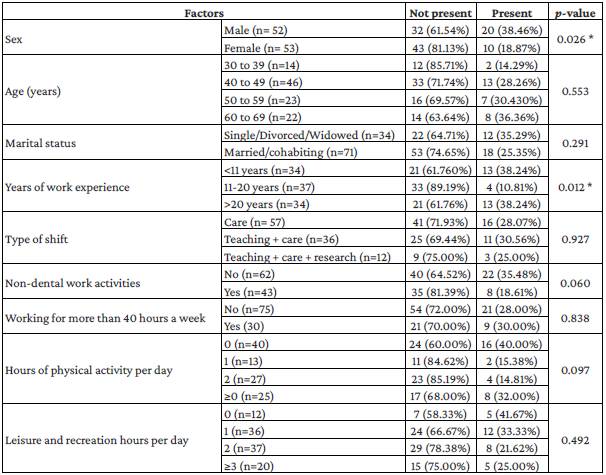
* Chi-square test.
Source: Own elaboration.
The analysis adjusted for all variables showed that sex and years of work experience were significantly associated with the presence of burnout syndrome. Thus, the prevalence in women was 47.00% lower than in men (aPR=0.53 p=0.044) and 70.00% lower in those who reported having between 11 and 20 years of work experience (aPR=0.30; p=0.017), compared with those with less than 11 years of work experience Table 6.
Discussion
Burnout syndrome occurs in workers whose work activity is based on interaction with other people; in addition, its prevalence has increased significantly among health professionals. 8,13 In this study, only 28.57% of the participants presented with burnout syndrome, a prevalence lower than that described in Peru by Robles- Velasquez & Caceres-Gutierrez, 8 who reported a prevalence of 59.1% (44.6% for severe burnout and 14.5% for moderate burnout), but much higher than the 2.8% described by Beas et al.13 in a study of 5 062 health professionals working in 181 urban and rural health centers in Peru. These differences could be explained by the fact that the study by Robles-Velasquez & Caceres-Gutierrez8 included not only MINSA dentists working in the public sector, but also dentists from the Armed Forces and Social Security hospitals, whose working conditions are different from those of MINSA institutions. Moreover, in the study by Beas et al.,13 the sample was much larger and included doctors and nurses.
In Latin America, in countries with work and socioeconomic contexts different from that of Peru, the prevalence of burnout syndrome is much lower in public sector dentists. For example, according to Odgón-Lebrón & Diaz-Reissner7 and Bonafé et at.,6 this syndrome occurs in 1.20% and 16.7% of these dentists in Paraguay and Brazil, respectively.
In the present study, when analyzing the results by dimensions, the levels of emotional exhaustion and depersonalization were high in 90.47% and 98.09% of the participants, respectively. This differs the figures reported in Paraguay by Odgón-Lebrón & Diaz-Reissner7 (10.84% and 3.61%, respectively) and in Brazil by Arias-Molina et al.19 (26.02% and 10.95%), who carried out a study in 73 stomatologists working in a university clinic in Bayamo. Likewise, it differs from the reports by Bonafé et al., 6 who found a prevalence of 36.67% and 35% for emotional exhaustion and depersonalization, respectively. On the other hand, the levels of the personal accomplishment dimension were high in only 35.23% of the sample, a frequency much lower than that reported in Paraguay (66.27%)7 and Brazil (89.93%).19 Thus, this dimension was responsible, in some way, for a greater number of dentists not being considered as cases of burnout; however, high levels of emotional exhaustion and depersonalization demonstrate the need for research that focuses on these dimensions.
When analyzing each dimension of the burnout syndrome and the behavior of associated factors, it was found that being female was significantly associated with high scores in the emotional exhaustion (p=0.006) and depersonalization (p=0.005) dimensions, while performing a non-dental work activity (p=0.015) and having between 11 and 20 years of work experience (p=0.024) were significantly associated with high scores in the personal accomplishment dimension. The higher levels of depersonalization among women contrasts with the findings of Castañeda-Aguilera et al. 20 in Mexico, who, in their study of 203 dentists from the Guadalajara Metropolitan Area, found that being male was a risk factor for this dimension.
Similarly, the fact that being a woman was significantly associated with high levels of emotional exhaustion and depersonalization and low levels of personal accomplishment may be explained because in Peru (a country where gender differences are still evident) being a woman working in the public sector is a cause of satisfaction and personal fulfillment. This could have also influenced the lower rates of burnout in this population compared with other studies, in which this dimension has been higher in women7,8 or no differences with respect to sex have been found. 6,9,21
Having between 11 and 20 years of professional practice compared with having worked for a shorter period was also associated with a lower presence of burnout syndrome, which is similar to that reported by Bonafé et al.6, who established that longer work experience and knowledge of administrative management processes predispose to a lower presence of this syndrome. The values of personal performance found in the present study were also higher in this group, which contributes to explaining this behavior.
In the present study, no other factors were found associated with the presence of burnout syndrome, which contrasts with the studies of Alemany-Martínez et al.22 and Calvache et al.,23 in which marital status was associated with its development, and Chipchase et al.24 and Jin et al.,25 who reported that a greater number of labor activities increased the tendency to develop it. For its part, it has been established that performing other activities not related to dentistry, be it work, leisure or physical activity, is considered a protective factor for the development of this syndrome. 16,21 This contrasts with the findings of the present study, where this factor was not significantly associated with the presence of burnout.
Finding high levels in the personal accomplishment dimension was decisive and allowed us to understand why having more working hours and a greater workload, and not having time for physical activity and recreation did not contribute to the presence of burnout. However, prospective designs are needed to better identify the factors associated with the presence of burnout, as well as to incorporate the evaluation of factors such as the condition of the work environment and interpersonal relationships in the work environment, which, according to Bonafé et al.,6 could have an impact on its development.
A limitation of the present study is that the MBI for health professionals and its cut-off points have not been validated in Peru, which could be a source of bias; however, its use has not shown any difficulties or major differences from the original version. 6,7,12,26 Moreover, as already mentioned, it has been used successfully in several works carried out in the country, 2,8,13,14,17 so the authors of this study consider that the results obtained with this instrument are valid and allow improving the scientific evidence on this subject. These results may also be considered when establishing preventive strategies for the appearance and control of burnout syndrome in dentists working in a context similar to that of the present study.














